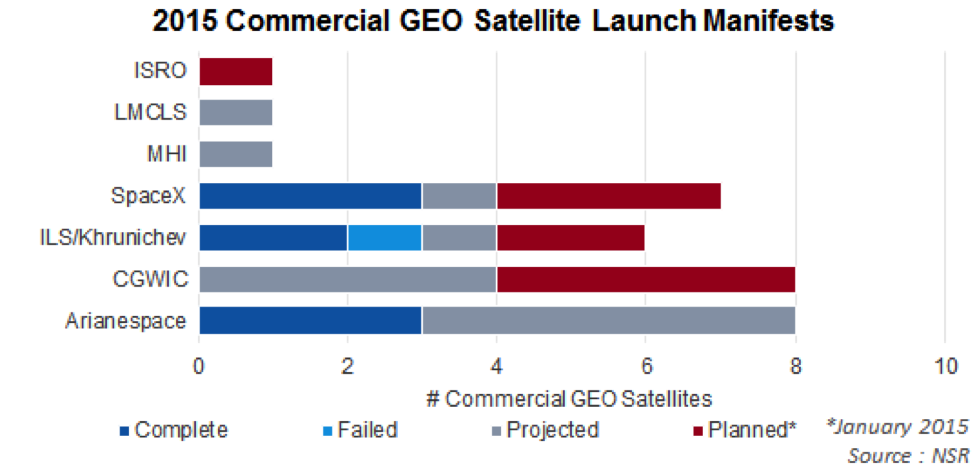Falcon 9 Loss a Failure for Industry at Large?
Jun 30th, 2015 by Carolyn Belle, NSR
Sunday’s Falcon 9 complete failure during a cargo resupply
mission to the International Space Station (ISS) was a first for the
vehicle, and the industry’s third in 2015. Valuable ISS supplies and
scientific experiments were lost during the mission, but this
event’s more lasting repercussions affect widespread stakeholders.
15 commercial and 3 government satellites are manifested for a
Falcon 9 launch in 2015, but it is unlikely more than one additional
mission will be completed before the end of the year. This spells
in-service date and revenue delays for the commercial operators, and
potential data lapses for government.
More significantly, the long-term reaction to Sunday’s failure
could herald a perception change of SpaceX and a strained
environment for the commercial satellite industry at large.
SpaceX Still Moving Forward
Coming on the heels of a $1 billion funding round and long
awaited U.S. Air Force certification, the Falcon 9 failure is an
unexpected hiccup in the SpaceX success story. How this could impact
the potentially lucrative U.S. national security launch market is
yet to be seen, but here SpaceX already faced steep competition from
incumbent ULA.
Despite being the newest entrant to the commercial launch market,
a low price and thus far good reliability have meant no trouble in
winning commercial contracts. NSR’s
Satellite Manufacturing and Launch Markets, 5th Edition, found
that SpaceX enjoyed 21% market share of commercial GEO backlog at
the end of 2014, a 5% jump over 2013. However, losing the position
of rookie star does not denote corporate disaster. Indeed, the path
to becoming a seasoned launch veteran inherently includes
challenges; the ability to promptly identify the cause of failure,
resolve issues, and return to flight is a step along the way.
The Falcon 9 now has a 5-year reliability rate of 89% compared to
100% and 85% for main commercial competitors Ariane 5 and Proton,
respectively. The key difference that operators will draw between
SpaceX’s failure and the Proton loss in May is the frequency of
failure: though the reliability rates are similar, the Proton has
experienced 4 complete and 4 partial failures in the last five
years, compared to just 1 complete and 1 partial for the Falcon 9.
Pending final conclusions of the technical review board, the SpaceX
cause of failure could be viewed more favorably than Khrunichev’s
consistent quality control issues. NSR therefore does not foresee
SpaceX suffering a material loss of future business as a result of
this event.
Hands Tied for Commercial Satellite Industry

At the start of 2015, 32 commercial GEO satellites were scheduled
to launch by the end of the year. Half way through, a mere 8 have
successfully launched and no more than 21 are expected to reach
orbit before 2016. These Proton- and Falcon 9-driven delays,
alongside postponed commercial LEO and government GEO/LEO missions,
will have knock-on effects into the 2016 and 2017 manifests of both
vehicles. Without Proton or Falcon 9 in operation in the near term
and catching up after a return to service, do operators have any
recourse?
In NSR’s view, not much. Arianespace is operating at full
capacity. Sea Launch has been quiet of late on plans for a vehicle
or launch site adjustment, but in 2014 had cited an ability to
conduct GTO launches in 2015 or 2016 with sufficient client notice.
MHI and Lockheed Martin are similarly under-booked for commercial
launches, but given government obligations do not have a manifest
that can accommodate additional clients in the next year. China
Great Wall Industry Corp. remains out-of-bounds for most commercial
payloads, and is also experiencing delays.
This emphasizes the importance of maintaining multiple vehicles
and launch service providers as viable market players. Operators
reference three LSPs as the minimum for a healthy market, but over
the past two decades the market has supported only two primary
players with an occasional tertiary player. The challenge is that
higher reliability and lower costs are associated with frequent
launches of a given vehicle, but the global market remains low
volume to the extent that not all LSPs operate at optimal rates.
Further, satellite operator contracting practices only occasionally
support market diversity in lieu of best mission value for the
company.
Bottom Line
Occasional launch failures are an expected, and even inevitable,
element of space utilization. Sunday’s Falcon 9 failure is a
momentary stumbling block that will impact clients in the near term
but should not lessen SpaceX viability in the long term if the
technical review is appropriately pursued.
Rather, the real implications of this failure are not for SpaceX
or even affected clients but in how commercial operators will
respond to experiencing two GTO vehicles out of service
simultaneously. The long expressed desire to have a distributed
launch services market could be more seriously pursued in coming
years. Diverse technologies are being realized to solve trapped
capacity in orbit, perhaps operators will now explore more solutions
to freeing trapped capacity on the ground.

